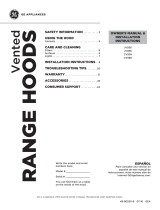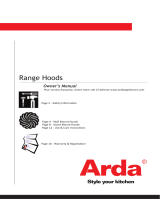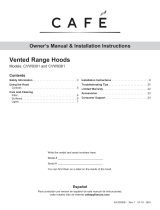Page is loading ...

Dynamic Cooking Systems, Inc.
ISLAND VENT HOOD
USE AND CARE
INSTALLATION INSTRUCTIONS
DCS-IVH-48
DCS-IVH-36

A MESSAGE TO OUR CUSTOMERS
Thank you for selecting this Dynamic Cooking Systems Professional Island
Vent Hood. Because of this appliance’s unique features we have developed this
Installation and Use Guide. It contains valuable information on how to properly
operate and maintain your new appliance for years of safe and enjoyable use.
To help serve you better, please fill out and return the Ownership
Registration Card and keep this Guide handy, as it will help answer questions
that may arise as you use your new vent hood.
For your convenience, product questions can be answered by a
DCS Technical Support Representative by phone:
1-888-396-2665, or Fax: 714-372-7003,
or by mail:
Dynamic Cooking Systems, Inc.
Attention Customer Service,
5800 Skylab Road, Huntington Beach, CA 92647

Introduction
1
Before proceeding with installation, please read this installation guide and
observe all safety precautions and warnings.
NOTE: Installation of this DCS Island Vent Hood must comply with all local
codes.
IMPORTANT- Save these instructions for the Local Electrical Inspector’s use.
INSTALLER- Please leave these instructions with the unit for the owner.
OWNER- Please retain these instructions for future reference.
Table of Contents
Important Safety Instructions 2
Features 3
Planning the Installation 4
Specifications 5
Site Preparation and Installation Guidelines 6
Soffit Installation 7-10
Ducting Information 11
Care and Use 12-14
Wiring Diagram 15
Warranty Information 16
Service 17

Follow These Precautions
Important Safety Instructions
2
CAUTION- TO REDUCE THE RISK OF ELECTRICAL SHOCK OR INJURY TO PERSONS
ALL VENT HOODS MUST BE INSTALLED WITH VENTILATORS THAT HAVE BEEN
APPROVED FOR USE WITH THE HOOD.
Make up air may be necessary to prevent air flowing down chimney, unsealed door,
window, or fire place opening.
WARNING- TO REDUCE THE RISK OF FIRE, ELECTRICAL SHOCK, OR INJURY TO
PERSONS, OBSERVE THE FOLLOWING GUIDELINES:
A) Installation and Electrical Wiring Must Be Performed By Qualified
Personnel In Accordance With All Applicable Codes & Standards,
Including Fire-Rated Construction.
B) To Prevent Back drafting, sufficient air is needed to maintain proper
combustion and safe exhausting of gases through the flue (chimney) of
fuel burning equipment. Follow the cooking equipment manufacturers
guideline and safety standards such as those published by the
National Fire Protection Association (NFPA) and the American Society
for Heating, Refrigeration and Air Conditioning Engineers (ASHRAE),
and the local code authorities.
C) Use caution when cutting or drilling into walls or ceilings as not to
damage electrical wiring and other hidden utilities.
CAUTION- TO REDUCE THE RISK OF FIRE AND TO PROPERLY EXHAUST AIR, BE
SURE TO DUCT AIR TO OUTSIDE. -DO NOT VENT EXHAUST AIR INTO SPACES
WITHIN WALLS OR CEILING, NOR INTO ATTICS, CRAWL SPACES, OR GARAGES.
NOTE- unit MUST be vented to the outside of the building.
IMPORTANT: Refer to ducting information supplied on Pg. 11

Island Vent Hoods DCS-IVH-48 & DCS-IVH-36
Features
3
The Dynamic Cooking Systems Island Vent Hood Models; DCS IVH 48 ,
DCS IVH 36, have been designed with the ultimate in household conve-
nience in mind.
Features include a high capacity, variable speed blower with speed
controller, commercial style dishwasher-safe filters, easy to clean
inside grease trays and four halogen lights with Hi/Low light switch.
(4)
halogen
lights
light on/off switch
blower variable speed
blower on/off switch
removable washable filters
hanger rods

We recommend that a backdraft damper be used in all Vent Hood installations. Cold
weather installations necessitate the use of a backdraft damper to minimize the flow of
cold air into the room. A non-metallic thermal break should also be installed to mini-
mize conduction of outside temperatures through the ductwork. Locate the thermal
break as close as possible to where the ducting enters the heated portion of the
house.
Before beginning installation of the Island Vent Hood and Ventilator, PLAN OUT the
entire installation procedure beforehand, considering the following areas:
HOOD SIZE & LOCATION- (The hood should be as wide or wider than the cooking
appliance with the hood being centered on the appliance. Vertically, the bottom of
the hood should be between 30
”-36” above the appliance cooking surface.)
DUCTING- (ducting transitions, air must flow to outside, use of Backdraft
damper...etc.)
ELECTRICAL REQUIREMENTS- (120 Volts, 60 Hz, 15 AMP Service, Local
Codes...etc.)
ADEQUATE MOUNTING SURFACES- (To support the weight of the vent hoods,
location of ceiling studs, additional support for safe ceiling mounting...etc.)
HANDLING NOTE- This Hood has been inspected prior to shipping to be free of
defects. Due to the weight of the Island Vent Hood and Ventilator; and to prevent
scratching or denting the unit, we recommend the use of two installers to move,
place, and secure the Vent Hood to avoid personal injury or damage to the Hood.
Backdraft Damper
Planning the Installation
4
Planning the Installation

Product and Venting Specifications
Specifications
5
843fi21
16"
52 5/8"
30"
16"
FRONT VIEW
SIDE VIEW
34 5/8"
12"
12"
34 5/8"
DCS-IVH-48
DCS-IVH-48
DCS-IVH-36
DCS-IVH-36
VENT HOOD DIMENSIONS
ntrol
30"
12"
TOP VIEW of DCS-IVH
18"
12"
TOP VIEW of DCS-IVH
venting specs 7" Ø
venting specs 4"x18" rectangular
Refer to venting specifications below when ordering the duct transition to 10ӯ.
for 36” Island Vent Hood.
See Page 11 for Ducting Information.

Site Preparation
Site Preparation and Installation Guidelines
6
You will need to create a secure soffit structure to mount the Island Vent Hood to
the ceiling. We suggest using 1 1/2 “ by 3 1/2 “ wood cut to fit the installation as
shown in the following pages. The soffit mounting to the top of the Island Vent Hood
will be 10 7/8 “ in length for the DCS-IVH-48 and 10 3/4 “ for the DCS-IVH-36.
These dimensions allow room for a 1/2 drywall duct cover. Do not deviate from
these dimensions when choosing a duct cover as the soffit structure must align with
the mounting holes on the Island Vent Hood. You are limited to a maximum of 1/2
inch on all sides.
NOTE: You will need to determine which type of duct cover will be used before
installation and leave enough space around the soffit for a flush mount between the
duct cover material and the top of the Island Vent Hood.
CAUTION- When installing the ISLAND VENT HOOD directly to the ceiling, adequate
structural supports are
CRITICAL to secure the unit. The Island Vent Hood is heavy,
weighing 128 LBS for the DCS-IVH 48 and 94 LBS for the DCS-IVH-36.
NOTE: The soffit height will vary according to the ceiling height.
GENERAL INSTALLATION GUIDELINES:
1) Determine the location for installation.
2) Determine the centerline of the installation.
3) If drywall is installed, cut away enough drywall to expose 2 ceiling joist (1 on
each side of the Hood center line)
4) Create your soffit structure according to ceiling height and attach soffit plates
for DCS-IVH-36 or soffit brackets for DCS-IVH-48 with screws to sides (see the
following pages for soffits and construction).
5) Attach soffit structure to existing ceiling joist.
6) Secure soffit with soffit braces according to model type (see diagrams page 7-
10).
7) Attach Island Vent Hood to soffit with the six 2 inch mounting screws provided.
Once the Island Vent Hood has been mounted in place it will be necessary to install
the electrical service. All electrical work should be done by a qualified electrician and
must conform to all local standards. Refer to the wiring diagram on Pg. 13 for proper
hook-up and grounding.
NOTE: Black=live, White=neutral, Green=ground
Complete the installation by making ductwork connections, testing unit functions,
and installing & finishing drywall.
Finishing the Installation:

Create your Soffit Struct
first and attach Soffit B
to each side with screws pr
36" ISLAND VENT HOOD SOFFIT MOUN
6 Mounting Screws
SOFFIT BRACKETS
SCREWED TO BOTH SIDES
OF SOFFIT STRUCTURE
SCREW SUPPORT BARS
ON BOTH SIDES AS SHOWN
CREATE YOUR
SOFFIT STRUCTURE
ACCORDING TO THE
CEILING HEIGHT
THEN ATTACH IT
TO THE CEILING JOIST.
843 fig 1
s
kets
ided
Soffit for DCS-IVH-36 Island Vent Hood
Soffit Installation
7
THE DIMENSIONS GIVEN ARE FOR A 1/2 INCH DRYWALL.
1) Create a soffit structure and attach the soffit brackets as in fig-
ure 1A. Refer to the installation guidelines on Page 6.
2) Attach the soffit support bars as shown in figure 2A.
3) After securing the soffit structure adequately to the ceiling joist,
attach the Island Vent Hood with the mounting screws provided,
figure 3A.
Refer to page 6 on finishing the installation.
SUPPORT
BARS
SOFFIT ASSEMBLY
FOR 36" ISLAND VENT HOOD
10 3/4 "
HEIGHT WILL
VARY
ACCORDING
TO CEILING
HEIGHT
16 3/4 "
The dimensions given
are for a 1/2 " drywa
FIG.3A
FIG.2A
FIG.1A

DCS-IVH-48 Island Vent Hood
Soffit Installation
8
ATTACH SOFFIT
BRACKETS
ON 4 CORNERS
OF THE
SOFFIT STRUCTURE
2 SUPPORT
BARS
SOFFIT ASSEMBLY
FOR DCS-IVH-48
10
7
/
8
"
HEIGHT WILL
VARY
ACCORDING
TO CEILING
HEIGHT
28
7
/
8
"
4 SOFFIT
BRACKETS
The dimensions given are for a 1
THE DIMENSIONS GIVEN ARE FOR A 1/2 INCH DRYWALL DUCT COVER.
1) Create a soffit structure and attach the soffit brackets as illus-
trated in figure 1B. Refer to the installation guidelines on Page 6.
2) Attach the soffit support bars as shown in figure 1B.
FIG.1B

Soffit for DCS-IVH-48 Island Vent Hood
Soffit Installation
28 7/8"
10 7/8"
TOP VIEW of DCS-IVH 48
SIDE VIEW for DCS-IVH 48 SOFFIT STRUCTU
1 1/2" x 31/2" Soffit
3 1/2"centerline
to centerline measurement
from screw to screw
Wood Structure
1
1/2" x 31/2" Sof
(4) soffit
brackets
The dimensions given are for a 1/2 " drywa
THE DIMENSIONS GIVEN ARE FOR A 1/2 INCH DRYWALL DUCT COVER.
3) After adequately securing the soffit structure to the ceiling joist,
attach the Island Vent Hood with the 6 mounting screws provided,
figure 2B and 3B shows the location of the mounting screws.
Figure 2B gives soffit dimensions allowing for a 1/2 inch duct cover.
9
FIG.2B

Diagrams for DCS-IVH-48 Island Vent Hood
Soffit Installation
10
counter top level
843 fig 4
FRONT VIEW of DCS-IVH 48
30" Min.
to cooking surface
Support Bars
Ceiling
Floor
Typical 96"
Ceiling Shown
Duct Cover
NOTE: Duct
Cover height
will vary according
to ceiling height
these must be
custom built.
6 Mounting Screws
Solid Soffit Structure
mounted to ceiling joices
THE DIMENSIONS GIVEN ARE FOR A 1/2 INCH DRYWALL DUCT COVER.
Figure 3B below illustrates a finished soffit structure for the
DCS-IVH-48
Refer to page 6 on finishing the installation.
FIG.3B

Duct Accessories
General
Ducting Information
DCS-IVH-48 Requirements
DCS-IVH-36 Requirements
When planning the path for ducting to the outside, keep in mind the following guide-
lines:
- Minimize use of elbows and transitions in ductwork as to maximize air flow to out-
side of building. An efficient airflow path contributes to the overall efficiency of the
Vent Hood.
- DCS recommends the use of
“smooth wall” ducting, not flexible ductwork.
- Transitions are required from rectangular to round ducting
(see transitions as shown below)
- Duct tape may be used at ducting joints.
- DCS recommends the use of 10
” round ducting which provides 78.6 In.
2
of sur-
face area.
- See Duct Accessories below on for ratio to 10
” transition.
- Alternate duct sizes in rectangular style may be used. If a rectangular duct style is
used, the duct must equal at least 78.6 In.
2
for best results. (
EExxaammppllee--
3 1/4”x 24”
duct = 78 In.
2
)
- Maintain consistent ducting square area as to avoid reduced air flow. [ie.- With a
IVH-48 Hood, connecting a 4
”x13” (
5522 IInn..
22
) to a 10”round (
7788..66 IInn..
22
) is not recom-
mended]
- DCS recommends the use of 7
” round ducting which provides 34.7 In.
2
of surface
area.
- Alternate duct sizes in rectangular style may be used. If a rectangular duct style is
used, the duct must equal at least 34.7 In.
2
for best results
- Wall Caps and Roof Caps must have free open area equal to duct size diameter.
- Note that a Sealed Back Draft Damper may reduce air delivery.
- Transition for right, left or rear air discharge also available.
10"
10
1
/2"
4
5
/8"
Vertical Duct Transition for 48" I
18
5
/8"
11"
11

Controls
Care And Use
12
Hood Lighting
Blower
We recommend you turn your hood on before you begin cooking to establish fresh
airflow. After you have finished cooking, let the blower run for a few minutes to
clear the air and help keep the kitchen fresh and clean.
The Blower is operated with 2 controls. The switch adjacent to the speed control
turns the blower on/off, while the speed control adjusts the blower speed. Turn the
speed knob clockwise to increase and counterclockwise to decrease the blower
speed.
A single switch controls the 4 halogen lights. The switch controls the brightness of
the lights with Hi/Off/Low. Use only 50w Max. Halogen Narrow Flood replacement
bulbs.
Caution! Halogen lamps are constructed of a glass bulb with a pressurized
internal filament tube that operates at high temperatures and could be discharged
into the fixture enclosure and/or surrounding environment, thereby creating a risk of
personal injury of fire. When replacing the bulb, let the bulb cool, and assure that
power to light has been turned off. Never allow a hot bulb to come into contact with
water.
Do Not Touch the Hood Light Bulbs when they are in use. They may be hot enough
to cause injury.
Blower
Blower Variable Speed Contr
Hood Lights
Halogen Light Bulb

Care And Use
13
When cool the appliance can be cleaned with hot soapy water, rinsed, dried and
buffed to a shine with a soft, heavy pile cloth. Always try this first, as it is the mildest
form of cleaning.
1. Some brands of cleaners are harsher than others. Read their instructions.
Try on a small inconspicuous area first.
2. To avoid marring the surface always rub metal finishes in the direction of
the polish lines. The cleaner will be more effective when used in the direc-
tion of the polish lines.
3. Use only clean sponges, soft cloths, paper towels, plastic non-metal soap
pads for cleaning or scouring, use only soap pads with soap still in them, a
dry pad can scratch the surface.
4. Be sure to rinse thoroughly and to wipe dry to avoid water marks.
Filters should be cleaned frequently in a detergent solution and are dishwasher
safe. Empty grease collection tray(s) regularly.
Unplug the Blower Motor before cleaning Ventilator.
Remove filters to access blower motor plug. Vacuum blower to clean.
Do not immerse in water.
Do not allow and excessive accumulation of grease.
Use a mild detergent when cleaning.
Do not use harsh abrasives, steel
wool pads, or abrasive cloths.
Filters and Grease Trays
Cleaning the exterior Stainless Steel finish:
FILTERS
GREASE TRAY

Cleaning the Grease Tray
Care And Use
14
Location of grease tray
DCS-IVH-36
DCS-IVH-48
Remove filter(s) by gently pulling up and out. The grease trays can easily be reached once
the filters are removed. Grease collection trays are easily accessible at the center beneath
the filter. See illustration below for location.

DCS-IVH-48 & DCS-IVH-36 Island Vent Hood
Wiring Diagram
15

16
Warranty Information
Length of Warranty
One (1) Year Full parts and Labor Covers the entire product
Five (5) Years Limited Switches and motor
All repair labor and parts found to be defective due to materials or workmanship for
one full year from date of purchase. Service must be provided by an Authorized
Factory Service Agent during normal working hours.
Installation or start-up
General maintenance
Shipping damage
Service by an unauthorized agency
Damage or repairs due to service by an unauthorized agency or the use of
unauthorized parts.
Service during other than normal working hours
Improper installation, such as improper hook-up, etc.
Service visit to teach you how to use the appliance; correct the installation;
reset circuit breakers or replace home fuses
Repairs due to other than normal household use.
Damage caused from accident, abuse, alteration, misuse, incorrect installation
or installation not in accordance with local codes
Units installed in non-residential application such as day care centers, bed and
breakfast centers, churches, nursing homes, restaurants, hotels, schools, etc.
This warranty applies to vent hoods used in residential applications; it does
not cover their use in commercial situations.
This warranty is for products purchased and retained in the 50 states of the
U.S.A., the District of Columbia and Canada. This warranty applies even if you
should move during the warranty period. Should the appliance be sold by the
original purchaser during the warranty period, the new owner continues to be
protected until the expiration date of the original purchaserís warranty period.
This warranty gives you specific legal rights. You may also have other rights
which vary from state to state.
DCS Will Cover:
DCS Will Not Cover:

How To Obtain Service:
Service
17
For warranty service, contact your local DCS authorized service agency. Be
prepared to provide the Model Number, Serial Number, and date of installa-
tion, and a brief description of the problem. If you need assistance in locating
the authorized service agency in your area please contact the DCS
Consumer Service Department for an authorized service agent near you:
(888) 281-5698.
Your satisfaction is of the utmost importance to us. If a problem cannot be
resolved to your satisfaction, please write or fax us:
Dynamic Cooking Systems Inc.,
Attention: Consumer Relations,
5800 Skylab Road, Huntington Beach, CA 92647
Fax us at: (714) 372-7003.

Litho in USA 8-99
Part No. 10843 rev.2
As product improvement is
an ongoing process at DCS,
we reserve the right to
change specifications or
design without notice.
Dynamic Cooking Systems, Inc.
5800 Skylab Road, Huntington Beach, CA. 92647
Tel: (714) 372-7000 Fax: (714) 372-7001
Parts/Customer Service (888) 281-5698
/



